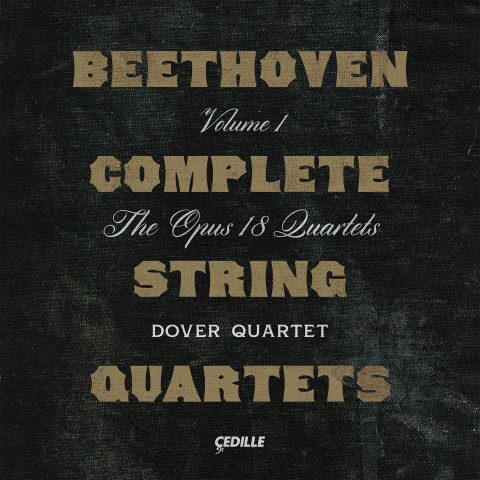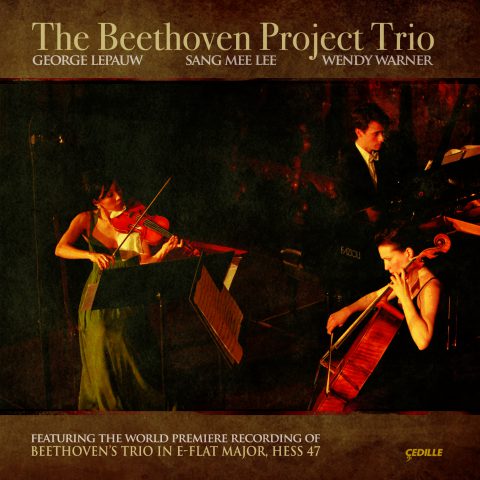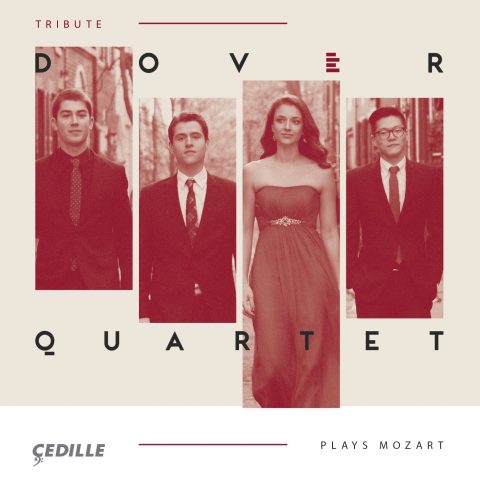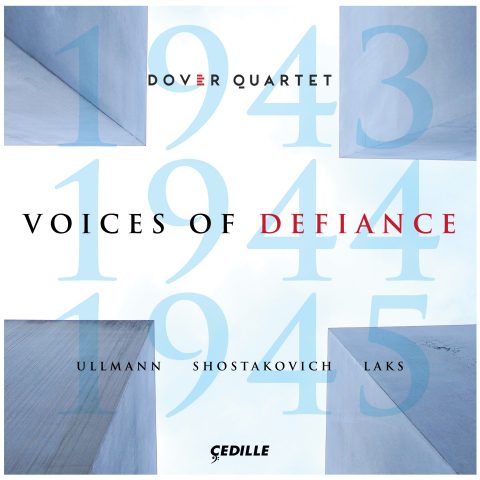Store
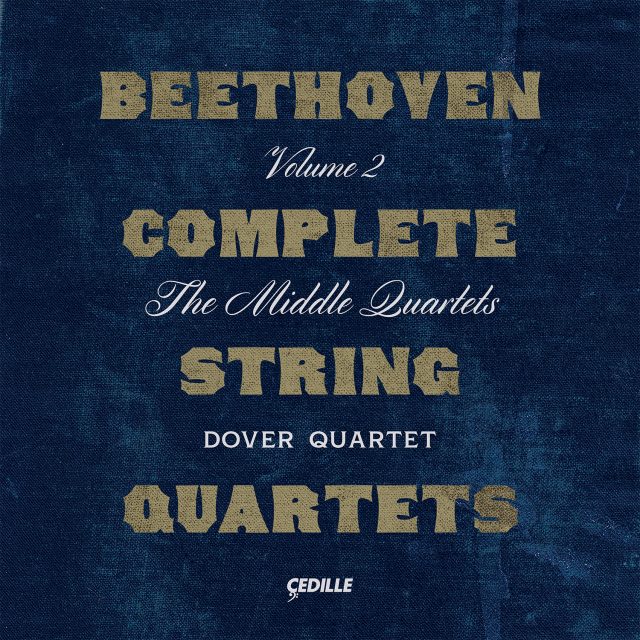
Store
Beethoven Complete String Quartets, Volume 2 — The Middle Quartets
The Dover Quartet, “the young American string quartet of the moment” (The New Yorker) unveils the second installment in its critically acclaimed Beethoven quartet cycle on Cedille Records.
The Dover’s three-disc set of Beethoven’s “Middle Quartets” includes the three Op. 59 “Razumovsky” Quartets, infused with Russian folk tunes; the graceful “Harp,” Op. 74, named for its plucked string figures; and the intense Op. 95 “Serioso,” a forward-looking experiment that Beethoven originally intended “for a small circle of connoisseurs.”
The Dover Quartet’s first Beethoven release, a traversal of the Op. 18 quartets, has garnered international praise. England’s The Strad said the ensemble exhibits “a beguiling freshness and spontaneity that creates the impression of these relatively early masterworks arriving hot off the press.” Toronto’s The Whole Note cited “performances of conviction and depth. This promises to be an outstanding set.” Utah-based CD Hotlist remarked, “The Dovers stand out from the pack by playing with utterly perfect intonation, a near-telepathic sense of ensemble, and a lovely balance of passion and clarity.” New York’s WQXR proclaimed, “It’s hard to imagine a group better suited to recording these works than the Dover Quartet.”
This recording is made possible in part by generous support from Patricia A. Kenney and Gregory J. O’Leary and the Elizabeth F. Cheney Foundation.
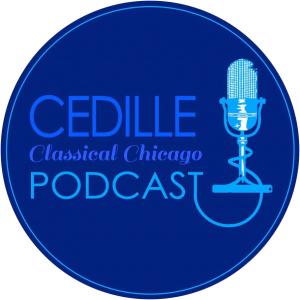
Listen to Jim Ginsburg’s interview with
Dover Quartet cellist Camden Shaw
on Cedille’s Classical Chicago Podcast
Preview Excerpts
LUDWIG VAN BEETHOVEN
(1770–1827)
String Quartet No. 7 in F major, Op. 59, No. 1
Artists
Program Notes
Download Album BookletNotes on the Middle Period Quartets
Notes by Nancy November
“The recording of these middle quartets represent the last sessions that Grammy winning recording engineer Bruce Egre engineered before he succumbed to cancer. He was a kind, warm, supportive force in every session, with incredible ears. Coming to what could be a stressful endeavor, recording the Beethoven Cycle, we were so fortunate to be in his calming and comforting presence. He was a mentor to so many, and loved dearly by all who worked with him. We miss him terribly.”
—Alan Bise and the Dover Quartet
(Joel Link, Bryan Lee, Milena Pajaro-van de Stadt, and Camden Shaw)
Op. 59: Genesis
After Beethoven composed his Op. 18 quartets (1798–1800, published in 1801), there is a gap of six years in his string quartet production. By the fall of 1804 at the latest, however, he was again considering writing new string quartets. In a letter to the Leipzig publisher Breitkopf und Härtel dated October 10, 1804, Beethoven’s brother Karl made an offer. Through Karl, Beethoven proposed to supply Breitkopf with two or three new string quartets. Karl stated that the quartets were not yet finished. In fact, they seem to have been only an idea of Beethoven’s at that time. The idea was possibly inspired by violinist Ignaz Schuppanzigh’s series of evening quartets that had been performed between 1804 and 1805. On November 3, 1804, Breitkopf answered Beethoven himself to show his interest. Karl, however, informed the publisher on November 24 that Beethoven was very busy working on his opera, Fidelio. The first version of which was ready in the summer of 1805.
It was not until November 1805 that the opera was premiered. It was then revised again for two further performances on March 29 and April 10, 1806. It is likely that Beethoven did not have time for quartet compositions until then. In the upper right corner of the first page of the autograph score (Beethoven’s handwritten manuscript) of Op. 59, No. 1, he noted, “Quartetto angefangen am 26ten May – 1806.” This is possibly the date on which he began work on that particular manuscript. Before that, he may have created sketches and first drafts.
Beethoven wrote the three quartets of Op. 59 in the context of several large-scale, “public” compositions. In a letter to his publisher dated September 3, 1806, he sought to discover whether the works would be accepted. In his letter to Breitkopf, he slyly claimed that he could send three quartets immediately. In addition, he had “a new piano concerto and a new symphony; and several other works.” This refers to the Fourth Piano Concerto, Fourth Symphony, Fidelio, and Christ on the Mount of Olives. The Concerto was probably mostly completed before he began the Op. 59 quartets; he had composed Christ on the Mount of Olives in 1803; and he probably composed the Fourth Symphony together with or just after Op. 59. This context is useful for understanding these works’ more “public” and expansive aspects (especially Op. 59, No. 1) as compared to the Op. 18 quartets.
Beethoven’s string quartets Op. 18 took a long time to compose. In contrast, the three Op. 59 quartets were written in a relatively short period and with apparently less effort. Beethoven made extensive use of his manuscripts to work on structural problems of quartet writing for his Op. 59 set. However, this practice was to change: the autograph manuscripts of the late quartets are generally cleaner than the earlier quartets’ autographs. It is clear that Beethoven was still dealing with questions of large-scale structure in the final stages of composing the first two Op. 59 quartets. In particular, he had to decide whether to repeat the development and recapitulation of the first movements. His final decision shows his preference for quartets with a strong sense of continuity, forward motion, and openness.
Much more than Op. 18, the Op. 59 quartets are considered well-integrated works, so much so that it has become common to refer to the set as a trilogy. Even in Beethoven’s time, they were perceived as a series, and collectively referred to as the “Russian Quartets.” But how exactly are these works related? The most obvious is their publication as a set with a single dedicatee. The three works were written as a result of a commission by the Russian ambassador in Vienna, Count Andreas Razumovsky. A patron of the arts, Razumovsky was soon (in 1808) to establish is own private string quartet, comprising violinists Schuppanzigh, and Louis Sina, violist Franz Weiss, and cellist Joseph Linke. Razumovsky had asked Beethoven to include a Russian theme in each quartet. Beethoven met this request by incorporating Russian folk songs in the first two quartets. In Op. 59, No. 1, the “Thème russe” (marked in the score) is the main theme of the finale. In No. 2, a different thème russe is heard in the second section of the third movement. Op. 59, No. 3 contains no explicit reference to a “Thème russe.” Mark Ferraguto has convincingly argued that Beethoven drew on a popular Russian lied (“Ty wospoi, wospoi, mlad Shaworontschek”) that had been transmitted in the German musical newspaper, Allgemeine musikalische Zeitung (as “Singe, sing’ein Lied” [Sing, sing a song]) in July 1804 — in other words, shortly before the composition of Op. 59.1 There are musical reasons to make this connection: the folksong is an A-minor Andantino in compound duple time, which shows similarities to the theme of the Andante con moto from Op. 59, No. 3.
Not only are the three connected by the use of folksongs, but in all three quartets we find strikingly audible, visual, and visceral gestures, notably large leaps between registers, trills, rising and scalic passages, and unisons. These gestures impart a sense of physicality, contributing to these works’ exploratory character and theatricality.
So there are manifold palpable links among the three quartets. But was Beethoven working towards a higher-level “opus idea” in Op. 59? Are these works cyclically integrated, as was to become a common procedure in large-scale musical composition in the 19th century? The answer might be a qualified “yes.” For example, there seem to be certain musical processes that play out across the set. Joseph Kerman speaks of a process of increasing end-orientation over the course of the opus.2 This can be understood in terms of the tonal tendency towards C (the key of resolution/hope/happiness), and also of the function of the coda across the work. While the first movement of Op. 59, No. 1 has an extensive coda, by the third quartet the weight of the coda has shifted clearly to the finale.
A further process that seems to develop across the opus is one whereby themes are immediately varied (“developing variations”). Wilhelm von Lenz nicely captured this process in his comments on Op. 59, No. 3: “once more a new composer and yet the same hallmark of unending fantasy.”3 This technique also manifests in the way movements tend to begin in medias res (“in the middle”): consider the opening of Op. 59, No. 1, which takes 19 bars to get to a perfect cadence in the home key of F major. Tonalities tend to “hover” and emerge in these works. This is especially marked in the outer movements of No. 3, both of which (as with the opening of No. 1) take some time to reach a strong cadence in the tonic. By these means, then, this sense of process-orientation emerges especially clearly in this opus.
There is also an increasingly prominent treatment of fugues across the three works, which could be heard as an important aspect of their cyclic integration. Striking in Op. 59, No. 3 is the way Beethoven makes parodistic use of fugues, contributing to the work’s theatrical aspect. Fugue is sounded as a serious element of composition in the development section of the first movement of Op. 59, No. 1; then treated with theatrical play in the third movement of Op. 59, No. 2; and finally resoundingly trumped by homophony in the finale of No. 3. This is especially apparent in the work’s final coda, where a tentative strand of polyphony gives way to a tour de force homophonic crescendo.
Op. 74: early performance
As with Op. 59, the impetus for writing Op. 74 may have come from the Schupannzigh Quartet’s concert series, which took place again in the winter of 1808–1809. Johann Reichardt reported regular quartet performances with Schuppanzigh and cellist Anton Kraft, as well as Sunday quartet parties held at the home of amateur cellist Nikolaus Zmeskall von Domanovecz, a close friend of Beethoven, when he was in Vienna.4
We can date the initial composition of Op. 74 to the period between May and September 1808, with the majority of the work probably written in August and September. In a letter to Breitkopf dated July 26, Beethoven complained bitterly about the disturbances and the noise caused by the French invasion and remarked of his own composition, “Since the fourth of May, little that is coherent has been brought into the world, only a fragment here or there.”5 The sketches for Op. 74 provide fascinating insights into Beethoven’s thinking about the work, which changed radically during the compositional process. In the sketch for the first movement, for example, there is no sign of the sweeping, harp-like pizzicato that appears in the final version and seems so characteristic of that movement. The much fuller and completely altered conception of this section appears later.
Beethoven’s autograph score is dated 1809 and would have been completed in the fall of that year. In a letter to Zmeskall that probably dates from November 1809, Beethoven invited his friend to a rehearsal of what was very likely Op. 74 at the house of Prince Lobokowitz. The letter is written in the cheeky tone that Beethoven sometimes adopted for his friend and sometimes adopted for Op. 74:
Cursed tipsy Domanovetz — not Count of music,
but Count of gluttony — Count of dinner, Count
of supper etc — The quartet is to be rehearsed
at Lobkowitz’s at half past ten or perhaps ten
o clock today. H[is] E[xcellency] who, it is true,
is generally absent so far as intelligence is
concerned, has not yet arrived — So do come
along….6
Many of Beethoven’s works were tried out in this manner, in private settings, before they were sent to the publisher. The performance probably took place shortly after the work’s completion. Another letter, from Countess Anna-Marie Erdödy from Vienna to Breitkopf, dated January 4, 1812, reports of a performance on March 31, 1810 “at a public occasion in my house in the presence of all of the most excellent composers and connoisseurs of music, with a then completely new quartet by Herr van Beethoven, whereby it received, if not a greater, then nevertheless quite the same general applause.”7 According to Countess Erdödy, the London pianist, composer, and publisher Muzio Clementi was among those present.
Despite their very different characters, both Op. 74 and Op. 95, show links to Beethoven’s incidental music to Goethe’s Egmont, Op. 84 (1810). The connections are subtle in the case of Op. 74: he had only just begun sketching ideas for Egmont during that quartet’s composition. The influence may even have worked more in the opposite direction, from chamber to theater: working on Op. 74 possibly helped him develop ideas for Egmont.
For Beethoven, a crucial text in Egmont was Klärchen’s lied, “Freudvoll und leidvoll.”8 The poem advocates a full experience of life and, by implication, love, entailing extremes of both pleasure and pain. It concludes with the declaration, at once challenging and comforting, that happiness belongs to those who continue to love despite and because of these dualisms:
Freudvoll/Und leidvoll/Gedankenvoll sein/
Langen und bangen/In schwebender Pein/
Himmelhoch jauchzend/Zum Tode betrübt;/
Glücklich allein /ist die Seele, die liebt.
[Joyful/And tearful/With care-filled brain/
Longing and fearful/In suspenseful pain/Now
on top of the world/Now cast down from above;/
Happy alone/Is the soul in love.]
There are no readily traceable musical links between Beethoven’s setting of this text and Op. 74, but Goethe’s invocation of duality and transcendence was likely an important source of inspiration for the unusual variations set that forms Op. 74’s finale.
These variations are paired: the odd- and even-numbered variations contrast increasingly dissociated versions, marked forte, with increasingly lyrical versions, marked sempre dolce e piano. Beethoven also moves to the median at the midpoint of the theme in each variation (except variation 6), which contributes to the “smoothing” effect in the even numbered variations more generally. By contrast, the odd-numbered variations become increasingly dissociated, mainly in texture and register. The arpeggiated character of variations one and five and the “ping pong” octaves in variation three suggest new and highly inventive developments of the “harp” idea first heard in movement one. By contrast, the voices of the second, fourth, and sixth variations are registrally and rhythmically contained; gently swirling, largely stepwise melodic lines and extensive slurring suggest a sinking into soft, sweet melancholy song, prominent in movement two.
Op. 95: “Never to be Performed in Public”
The “public occasion” to which Erdödy’s letter (quoted earlier) refers was, in fact, semi-private: the guests had been invited, there had been no ticket sales or marketing, and the event took place in a private apartment. This was the first and most common context for the performance of string quartets in this period. It may not be surprising, therefore, that Beethoven wrote the following performance instruction in a letter to George Smart dated October 7, 1816: “N.B. The Quartet [op. 95] is written for a small circle of connoisseurs and is never to be performed in public. Should you wish for some quartets for public performance I would compose them to this purpose occasionally.”9
And yet the work was performed in May 1814 at a public Prater matinée in Vienna. Did this performance contradict Beethoven’s seemingly explicit instruction? Probably not. In his letter to Smart, Beethoven wrote about the English market for his music and was not trying to find the “right” audience for the F minor Quartet for all times and places. Just as the complexity of Mozart’s music took a while to catch on in England, a Beethoven work strongly oriented toward the new German aesthetic would have been a difficult product for the market there. The work, which Beethoven titled “quartetto serioso,” is characterized by extreme conciseness of musical material, pioneering departures from traditional forms, and a predominantly tragic and violent tone associated with the composer’s turbulent private life in 1810.
Theodor Helm suggestively remarked that in this work Beethoven spoke with the quick-witted brevity of the true dramatist.”10 And Beethoven was, in fact, working as a dramatist then: the only other major work he composed in 1810 was his incidental music to Goethe’s Egmont, also in F minor, a comparatively unusual key for the time. The two works were completed in close succession and have several points of contact besides the key. Perhaps most striking are their respective finales. The Victory Symphony that concludes Egmont is related to the quartet’s final coda in its fast tempo (Allegro con brio in Egmont, Allegro in Op. 95), textural build-up through polyphonic voices, considerable range of pitch, and surprising return of the tonic-major after a strong emphasis on the minor. Despite its smaller proportions, one can glimpse in the quartet’s coda something of the collective jubilation of Egmont, where the Victory Symphony heralds the future triumph of the Netherlands and indicates that Egmont did not die in vain. At the end of the quartet, one also feels the exhilaration of overcoming tragedy.
Nancy November is an Associate Professor in musicology at The University of Auckland, New Zealand and the author of numerous books including Beethoven’s Theatrical Quartets: Opp. 59, 74, and 95 (Cambridge University Press, 2013) and Cultivating String Quartets in Beethoven’s Vienna (Boydell Press, 2017).
Album Details
Producer Alan Bise
Engineer Bruce Egre
Digital Editor Alan Bise
Recorded
December 16–18, 2019; July 10–12 and August 7–9, 2020 at Sauder Concert Hall, Goshen College, Goshen, IN
Graphic Design Bark Design
© 2021 Cedille Records
CDR 90000 206
